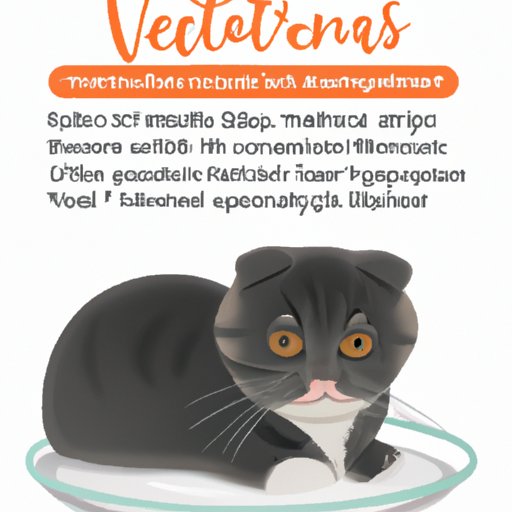
Introduction
Feeding your cat appropriately is essential to ensure its health and well-being. Cats require a specific diet to meet their nutritional needs, and overfeeding or providing inappropriate food can lead to various health problems. As a cat owner, it is crucial to understand how much food your cat needs and what type of food suits its diet. In this article, we will provide you with guidelines, tips, and information on how much you should feed your cat, how to avoid common feeding mistakes, and how to ensure your feline friend’s overall health.
Importance of Portion Control for Cats
The amount of food your cat needs depends on different factors, including age, weight, and activity level. Portion control is essential to maintain your cat’s weight and prevent obesity, which can lead to several health issues such as arthritis and diabetes. Adult cats generally require around 24-35 calories per pound of body weight per day. However, obese or less active cats might require a lower calorie intake. Kittens, on the other hand, need to be fed more frequently, up to four meals a day, to meet their energy requirements for growth and development.
A proper feeding schedule, such as feeding at the same time each day, using measuring cups, and keeping track of portion sizes, can ensure portion control. You can also find feeding guidelines on the packaging of commercial cat foods, which generally provide the recommended amount of food based on your cat’s weight and activity level.
Common Mistakes and How to Avoid Them
Overfeeding, free-feeding, feeding table scraps, and feeding inappropriate food are common feeding mistakes that owners might make. Overfeeding can lead to obesity and other health problems, while free-feeding can make your cat gain too much weight and lead to picky eating habits. Table scraps or human food are also not recommended for cats as they might be high in fat, salt, or sugar, or contain toxic ingredients. Feeding inappropriate food, such as dog food or vegan diets, can also lead to nutrient deficiencies and health issues.
To avoid these mistakes, you should establish a feeding schedule that suits your cat’s needs and only feed your cat a balanced and nutritionally complete diet. Using measuring cups can help you control portion sizes, and avoiding human food or scraps can prevent your cat from developing bad eating habits.
Understanding Nutritional Needs of Cats
Cats require specific nutrients in their diet to maintain their health and well-being. Proteins are essential for muscle repair and growth, and fats provide energy and support healthy skin and hair. Carbohydrates also play a role in energy production, but cats require a lower amount than dogs or humans. Vitamins and minerals are also crucial to maintain essential functions, such as vision, nervous system, and immune system.
There are different types of cat food available, including wet and dry food. Wet food has a higher moisture content and can be beneficial for cats with kidney or urinary tract problems. Dry food, on the other hand, is more convenient and can help keep your cat’s teeth clean. Both types of food can provide a balanced and complete diet if they contain the appropriate amount of nutrients.
When choosing cat food, you should prioritize ingredients such as meat, fish, or poultry as they provide high-quality protein. You should avoid foods that contain fillers, by-products, or artificial ingredients, as they lack nutritional value and might contain harmful substances.
Introducing a New Feeding Routine
If you want to switch your cat to a new feeding routine or type of food, you should do it gradually to avoid digestive problems or stress. You can introduce new food by mixing it with the old food, slowly increasing the amount of new food over a few days. It might take a few weeks for your cat to adjust to a new feeding routine, and you should monitor its weight and appetite during this period.
If you are changing from dry food to wet food, you should check the appropriate feeding guidelines as wet food is usually less calorie-dense than dry food. You can also add some water to your cat’s dry food to increase its moisture intake and reduce the risk of urinary tract problems.
Potential Health Risks of Overfeeding
Overfeeding your cat can lead to several health problems, including obesity, diabetes, and heart disease. Obesity can cause joint pain, lethargy, and respiratory problems. Diabetes can lead to increased thirst, frequent urination, and weight loss. Heart disease can lead to fluid buildup in the lungs and chest cavity, causing breathing difficulties.
You can recognize signs of overfeeding by monitoring your cat’s weight and appetite regularly. If you notice any significant changes, you should consult your veterinarian and adjust the feeding routine accordingly.
Debunking Common Cat Feeding Myths
There are several myths related to cat feeding, such as the belief that cats require milk in their diet or that dry food is the best option. These myths are not scientifically supported and can be harmful to your cat’s health.
Cats do not need milk in their diet and might even be lactose intolerant, leading to digestive problems. Dry food is a convenient option, but it might contain more fillers and harmful ingredients than wet food. Both wet and dry food can provide a balanced and complete diet if they suit your cat’s nutritional needs.
Conclusion
Feeding your cat appropriately is vital to ensure its health and well-being. Portion control, balanced nutrition, and avoiding common feeding mistakes can keep your feline friend happy and healthy. Understanding your cat’s nutritional needs, introducing a new feeding routine gradually, and watching for signs of overfeeding can prevent health problems and prolong your cat’s lifespan. Always consult with your veterinarian to ensure that your cat receives the best feeding recommendations for its individual needs and preferences.




